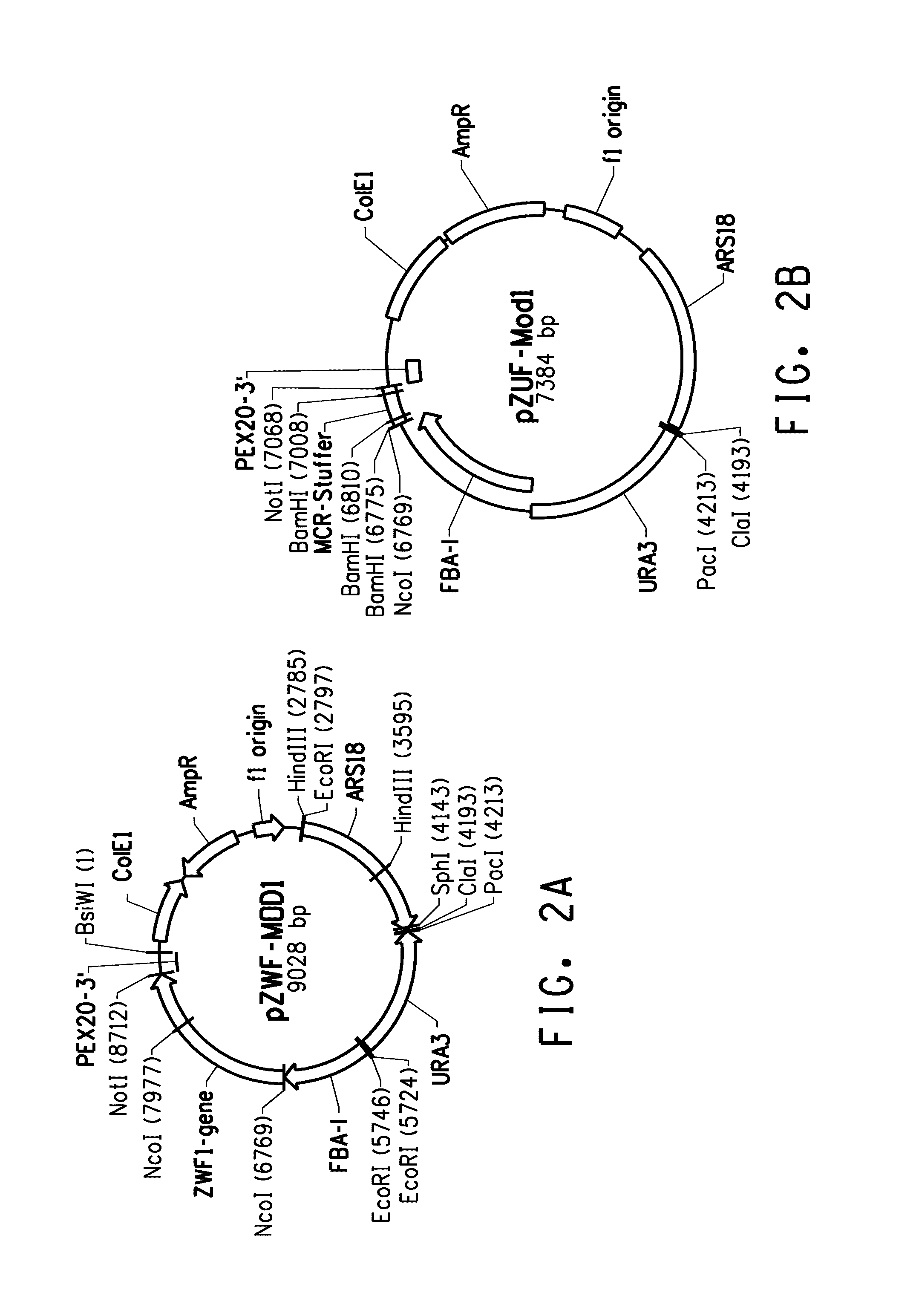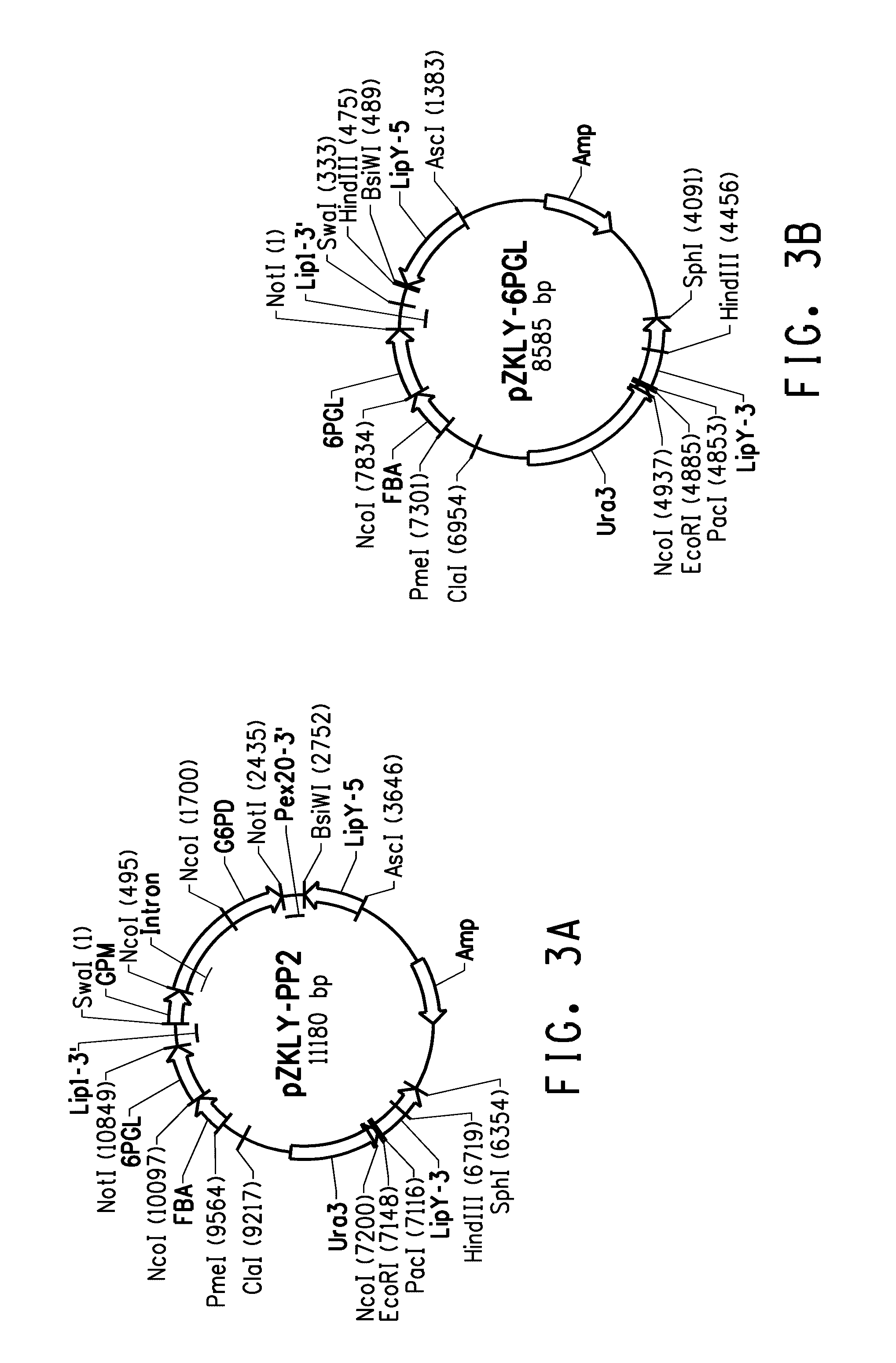Pentose phosphate pathway upregulation to increase production of non-native products of interest in transgenic microorganisms
a technology of pentose phosphate and non-native products, applied in the field of biotechnology, can solve the problem that the product of this enzymatic reaction, delta-6-phosphogluconolactone, can be toxic to the cell
- Summary
- Abstract
- Description
- Claims
- Application Information
AI Technical Summary
Benefits of technology
Problems solved by technology
Method used
Image
Examples
example 1
Over-expression Of Glucose-6-Phosphate Dehydrogenase (“G6PDH”) In Yarrowia lipolytica Strain Y2107U
[0244]The present Example describes construction of plasmid pZWF-MOD1 (FIG. 2A; SEQ ID NO:7), to enable over-expression of the Yarrowia gene encoding glucose-6-phosphate dehydrogenase [“G6PDH”] under the control of a strong native Yarrowia promoter.
[0245]Transformation of the PUFA-producing Y. lipolytica strain Y2107U with the over-expression plasmid was performed, and the effect of the over-expression on cell growth and lipid synthesis was determined and compared. Specifically, over-expression of G6PDH resulted in decreased cell growth.
Construction of Plasmid pZWF-MOD1, Comprising Yarrowia G6PDH
[0246]The Yarrowia lipolytica G6PDH ORF contained an intron near the 5′-end (nucleotides 85-524 of SEQ ID NO:10). The nucleotide sequence of the cDNA encoding G6PDH is set forth as SEQ ID NO:1.
[0247]Primers YZWF-F1 (SEQ ID NO:8) and YZWF-R (SEQ ID NO:9) were designed for amplification of the co...
example 2
[0261]Construction of Plasmid pZKLY-PP2, for Coordinately Regulated Over-Expression of Glucose-6-Phosphate Dehydrogenase [“G6PDH”] and 6-Phosphogluconolatonase [“6PGL”]
[0262]The present Example describes construction of plasmid pZKLY-PP2 (FIG. 3A; SEQ ID NO:15) to over-express the Yarrowia genes encoding glucose-6-phosphate dehydrogenase [“G6PDH”] and 6-phosphogluconolatonase [“6PGL”] in a coordinately regulated fashion. Specifically, a weak native Yarrowia promoter was selected to drive expression of G6PD, while a strong native Yarrowia promoter was operably linked to 6PGL. This strategy was designed to ensure rapid conversion of 6-phosphogluconolactone to 6-phosphogluconate and thereby avoid accumulation of toxic levels of 6-phosphogluconolactone.
Construction of Plasmid pZKLY-PP2 for Over-Expression of G6PDH and 6PGL
[0263]Construction of plasmid pZKLY-PP2 first required individual amplification of the Yarrowia 6PGL and G6PDH genes and ligation of each respective gene to a suitable...
example 3
Coordinately Regulated Over-Expression of Glucose-6-Phosphate Dehydrogenase [“G6PDH”] and 6-Phosphogluconolatonase [“6PGL”] in Yarrowia lipolytica Strain Y4305U Increases Total Lipids Accumulated
[0268]The present Example describes transformation of PUFA-producing Y. lipolytica strain Y4305U with plasmid pZKLY-PP2 and the effect of coordinately regulated over-expression of G6PDH and 6PGL on cell growth and lipid synthesis. Specifically, coordinately regulated over-expression of G6PDH and 6PGL resulted in an increased amount of total lipid, as a percent of DCW, and an increased amount of PUFAs, as a percent of TFAs, in the transformant cells.
[0269]Y. lipolytica strain Y4305U (General Methods) was transformed with an 8.5 kB AscI / SphI fragment of pZKLY-PP2 (SEQ ID NO:15; Example 2), according to the General Methods. Transformants were selected on SD media plates lacking uracil. Three pZKLY-PP2 transformants were designated as strains PP12, PP13 and PP14.
[0270]For lipid analysis, pZKLY-P...
PUM
 Login to View More
Login to View More Abstract
Description
Claims
Application Information
 Login to View More
Login to View More - R&D
- Intellectual Property
- Life Sciences
- Materials
- Tech Scout
- Unparalleled Data Quality
- Higher Quality Content
- 60% Fewer Hallucinations
Browse by: Latest US Patents, China's latest patents, Technical Efficacy Thesaurus, Application Domain, Technology Topic, Popular Technical Reports.
© 2025 PatSnap. All rights reserved.Legal|Privacy policy|Modern Slavery Act Transparency Statement|Sitemap|About US| Contact US: help@patsnap.com



